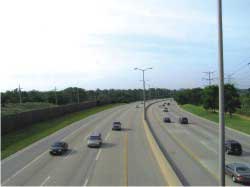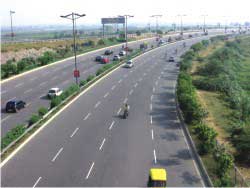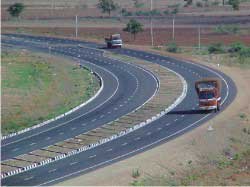Promotion and Development of Roads and Highways Network in India

"Today, India is a leading destination for infrastructure spending and is underscored by the aspirations laid out in the Eleventh Five Year Plan, this sector offers tremendous growth potential. I would like to assure the players already part of the sector and also those who wish to enter into the roads and highways sector of the huge potential that remains to be tapped in India. We are at the beginning of the Infrastructure Decade–a decade that will lay the foundation for inclusive growth and prosperity," says Shri Kamal Nath, Minister of Road Transport and Highways, in an Interview with S.A.Faridi and S.K.Khanna.
Sir, your being at the helm of affairs for the promotion and development of roads and highways network in the country has infused a fresh air of optimism in the sector. In a short span of time, the Hon'ble Ministerhas understood very well industry's dilemmas debilitating the progress of road projects. Are these dilemmas due to industry's internal concerns about the liquidity crunch, slow influx of funds in road projects or due to external concerns about dithering in policies, flawed procedures and skewed approachin the management and implementation of road sector projects?
The single most important concern which apparently amplified others, appears to be the drying up of the liquidity in the system during the second half of 2008, predominantly due to the global financial market meltdown. The effects lingered on for some more time. In order to accelerate the pace of National Highway Development, I have held consultations with all stakeholders with the aim of better understanding and appreciating their concerns and thereby create an enabling environment. The Prime Minister has constituted a committee under Mr B.K. Chaturvedi to examine the issues many of which related to the RFP, RFQ, MCA (standardized bidding documents). Most of the recommendations of the Chaturvedi Committee, constituted by the PM, on these issues have been approved by the Cabinet Committee on Infrastructure.
Now the worst time is getting over swiftlydue to new initiatives in place and the expectations of fast - track implementation are back. How are some of the contentious issues confronting the sector such as procrastination in complete and seamless land acquisition, MCA's distortions, dispute resolutions, standardized bidding documentation and related aspects of contract management are proposed to be tackled to create an enabling milieu for the industry? Will the recommendations of Chaturvedi committee on some of these issueshelp motivating new contractors aspiring to be investorsin road construction work?
Land acquisition involves state government functionaries and thus requires co - operation from the state governments. I have met chief ministers from several states and all of them have shown keenness for the road projects as roads lead to development. The task of making land acquisitions swifter has been taken as a challenge and work is being done on a war footing through the creation of special land acquisition units. Nearly 170 of such dedicated units will be set up across the country, of which 55 have already been set up. We are revising the internal process of land acquisition and attempting to bring down the time taking around 8 months from the current practice of 18 months.
As mentioned earlier, we have placed the distortions occurring due to provisions in MCA, RFP, RFQ before the Chaturvedi Committee with our suggested remedial formulations. We are hopeful that once these are through, by and large, all issues related to standardize bidding documents would be resolved and the industry will feel the difference, with a more enabling atmosphere. We are sure that once the risk perception is lowered, the sector would see new entrants and greater activity.
Public Private Partnership (PPP) in the road sector has always been a successful story so what further policy initiativesare being proposed to strengthen this model? How can private sector's current capacity be expanded to promote rapid developments through PPP route?

Roads and highways development remains to be a domain of the Government through its nodal agency NHAI, which has its own limitations due to its technical, project management, consultancy expertise, and accountability deficit and has been by and large failed to deliver the results as was expected. How does the new reality of development work NHAI is proposed to be strengthenedwith new technical inputs and make it more accountable to handle future projects as over 165 new road projects are expected to be undertaken by it under NHDP by 2010-11?
NHAI has, for the past 4-5 years worked under many constraints including, as you yourself has mentioned, "MCA distortions" and "flawed procedures" and "related skewed approach in the management and implementation of road sector projects." Once the burden of these is removed, which is what we are trying to do, we are sure NHAI will perform much better. As an autonomous body certain decisions need to vest in NHAI. As far as the issue of accountability is concerned, we have made CGM’s responsible for all the projects in the state under their charge. Other structural changes have also been done and regional offices have been set up at 10 out of the proposed 12 places. My objective is to decentralize and devolve more powers at the levels where it is required so that there is faster execution of projects.
MoRTH has set up an ambitious target to build 7000 km of roads annually for the next five years at 20km a day basis involving an investment of Rs 1000 billion. What are mega road projects proposed to be taken up in the next 2-3 years? How will be the prompt influxof fundingand modified financing schemesensured. On what model these projects will be undertaken?

A word about MoRTH proposal to lease out road projects to private entities to facilitate fund requirements.
The proposal to lease out highway projects was as an alternative to the current system of licensing of highway stretches under the concession arrangement, so that leased highways can, if offered as security to lenders, making loans to the developers more of a "secured loan" and consequently attracting better response / terms from lenders. We are considering leased highways, though we still need to work on State stamp duty aspects if we are to truly benefit out of it.

The Expressway Authority of India would be structured in a manner similar to National Highways Authority of India. Currently, it is set up as a division within NHAI and later it is intended to be made into a separate authority. The Government is thinking of adopting Swiss Challenge model on some of the stretches.
Of late, the Hon'ble Minister has been holding road shows in different countriesto attract foreign investors, financial institutions for investing in road projects in India. What has been the response from India and overseas road construction companies to participate in road projects in India? To lure international developers and contractors - what are the plans to redesign road projects to make them more viable as well as attractive for these players?
Today, India is a leading destination for infrastructure spending and is underscored by the aspirations laid out in the Eleventh Five Year Plan, this sector offers tremendous growth potential. Highways have a large shelf of projects which can be readily offered to the market including those which had a serious setback last year due to the global financial meltdown. Given our historical underinvestment in highway infrastructure and the role this sector can play in stimulating economic growth, we believe it imperative that adequate investment flows are attracted to this segment.
We also feel that in this discontinuous time, players looking to finance highway infrastructure spend would benefit from a fresh assessment of the opportunity. We have also to convince them that notwithstanding the structural challenges, the profit pool remains large and attractive, with potential for players to enlarge exposures. For the investment levels the highway sector requires, domestic sources would need to be supplemented with overseas funds.
To achieve this objective, after deliberations with knowledgeable players in the market, we have decided to conduct a series of road shows in major overseas investment centers. So far, such road shows have been held in Singapore, Zurich, London and New York. The response we have got is highly encouraging and we have had a number of enquiries and clarificatory mails, from PE funds, sectoral funds investing in infrastructure and other large investors. We are planning to have mega projects which would be more interesting to such investors.
It is really a paradox that while Hon'ble Minister is trying hard to rope in overseas funding and overseas players in construction of roads in the country, at home road and highway projects funding by multilateral institutions like the World Bank and Asian Development Bank to the tune of Rs 23,556 crore remain short of target, causing embarrassment to the Government. Isn't there a felt need to place a special panel to oversee the progress of such projects funded by multilateral institutions?
We need to accept the fact that ground conditions in certain states make execution of projects logistically more difficult. Due to such difficult conditions existing in certain states, there have been, slip-ups in execution of certain projects and these happened to be funded by these multilateral development agencies. These loans were not optimally utilized. We are aware that these projects require a more rigorous follow up and these issues are being addressed.
There is an urgent need to take a call on two important issues, one relating to streamlining toll collectionand toll notification system, particularly linking toll to projectcost as well as length of the roads and bringing uniformity in toll collectedfrom publicly and private funded road project so as to improve viability of the project. How is it proposed to be done under the new initiativesincluding greater use of electronic tolling technology?
Toll rates for highways are fixed according to statutory rules made under the NH Act, 1956. In 2008, we had announced revised Rules, bringing in a new toll structure. Concessions granted prior to this date obviously would have a different toll structure. We are looking at the possibility of an integrated seamless toll collection system, electronically controlled with a pan-India foot print.
The other overreaching concern relates to poor quality of feasibility and DPR prepared for the road projects by various consulting firms. Experience indicates huge variations in the TPC (total project cost) prepared for NHAI and those preparedfor private companies by the consulting firms. How can these lacunae be resolved and how the Ministry with more projects in hands is equipping itself with a sound project appraisal and monitoringsystem to analyzethese differences in project costs so as to restrict inflated estimates and assumptions to their logical limits?
With regard to Feasibility Reports and DPR's prepared for the road projects by consulting firms, mainly the complaints have revolved on Total Project Cost (TPC) value, i.e TPC as assessed in the DPR / Feasibility Reports vis-à-vis those assessed by the developers reportedly have large difference between them. But it needs to be realized that TPC is the capitalized cost of various cost components and these, generally differ even from developer to developer. Further, the margin taken by EPC contractors can also differ from developer to developer. In DBFO mode of BoT (Toll) execution, detailed design responsibility lies with the Concessionaire and here also cost would vary between awards. Hence it is difficult to conclusively state which TPC reflects the correct value. At the same time, we realize the importance of better and sound DPRs and steps are being taken to ensure that the DPRs and Feasibility reports are sound and solid.
Is there a need to set up a regulatory frameworkto address various issues confronting road and highwaysector? Industry hopes that soon there would be an independent mechanism to monitor toll rates, legal arbitration mechanismand resolving conflicting interests, introducing modern road standards and safety measuresto rejuvenate road sector nationwide.
Many of NHAI's functions are regulatory in nature. The Toll rules are notified / laid down by the Central Government under NH Act, 1956. Road standards and safety measures are stipulated by technical parameters laid down by Indian Road Congress. Even as of now, there are varying agencies which independently regulate many of the issues related to highways.
As per reports, roads and highways built by private players are of poor quality and even the BoT projects also suffer from the same malady. Is the Government considering to have a committee to make these road developers accountable for quality?
Yes, the accountability lies with contractors as they have buillt roads and highways on BoT basis and they have to be responsible for the quality. If the quality is not upto the mark, the builder of the road would be responsible for maintaining the road for the next 20 years and he will suffer under the BoT module.
What about the non-BOT projects?
For that the Transport Ministry is contemplating to frame certain building manuals but has not yet given final thought to it.
A million of thanks Sir for sharing your views on various points raised in this questionnaire. In addition to this, we very much look forward to your kind message to our wide cross sections of our readers which include road construction and infrastructure development companies, construction equipment manufacturers, construction and allied industries, reiterating your focus that roads, highways and related infrastructure development is good sector that can impart momentum to country's economy.
I would like to assure the players already part of this sector and those who wish to enter into the roads and highways sector of the huge potential that remains to be tapped in India. We are at the beginning of the Infrastructure decade–a decade that will lay the foundation for inclusive growth and prosperity.
NBMCW - November 2009


















